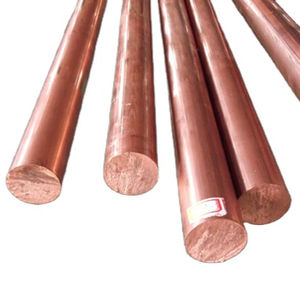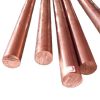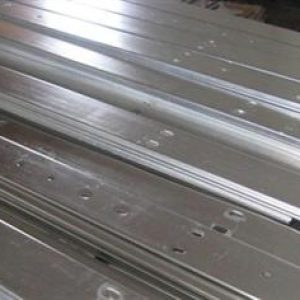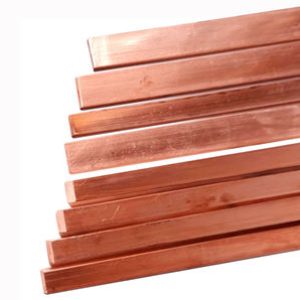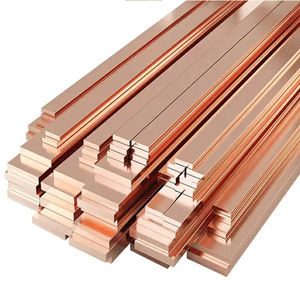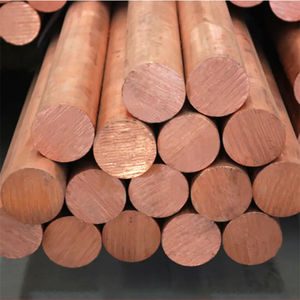Overview of ASTM B152 EN 14306Plumbing Electrical wiring Heat exchanger Copper round bar Copper Rod
A copper bar, also known as copper billet or ingot, refers to a solid, rectangular or square-shaped piece of pure copper or copper alloy. These bars are characterized by their robustness, dimensional accuracy, and metallurgical consistency, making them ideal for applications requiring high mechanical strength and/or electrical conductivity. Copper bars are typically produced through casting, extrusion, or hot rolling processes, resulting in a range of sizes and shapes to accommodate diverse industrial needs. They can be supplied in standard lengths or custom-cut to specific dimensions based on the end-user’s requirements.
Copper Bar of ASTM B152 EN 14306Plumbing Electrical wiring Heat exchanger Copper round bar Copper Rod
-
Strength and Durability: Copper bars exhibit good mechanical strength and toughness, enabling them to withstand high stress loads without fracturing.
-
High Conductivity: Like other copper forms, copper bars offer excellent electrical and thermal conductivity, which is essential in electrical and heat transfer applications.
-
Corrosion Resistance: Copper naturally corrodes at a slow rate and forms a protective patina, making it resistant to atmospheric corrosion and suitable for prolonged exposure to the elements.
-
Workability: Copper bars can be easily machined, drilled, turned, or otherwise fabricated into intricate shapes and components without compromising their integrity.
-
Versatility in Alloys: Copper can be alloyed with other metals to create bars with customized properties, such as increased hardness, wear-resistance, or specialized temperature and pressure tolerance.
Applications of ASTM B152 EN 14306Plumbing Electrical wiring Heat exchanger Copper round bar Copper Rod
-
Machinery and Equipment: Copper bars are used in the production of heavy machinery components, gears, and bearings due to their strength and wear resistance.
-
Construction: For structural applications, electrical grounding systems, and architectural accents where both strength and aesthetics are desired.
-
Electrical Engineering: In the fabrication of busbars, switchgear components, and transformer parts where high electrical conductivity and durability are needed.
-
Transportation Industry: Copper bars are integral to the production of parts for automobiles, railways, and aerospace due to their combination of strength and conductivity.
-
Forging and Casting: Serves as raw material for further manufacturing processes like forging into intricate shapes or melting down for casting complex components.
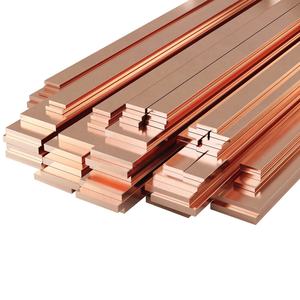
(ASTM B152 EN 14306Plumbing Electrical wiring Heat exchanger Copper round bar Copper Rod)
Parameters of ASTM B152 EN 14306Plumbing Electrical wiring Heat exchanger Copper round bar Copper Rod
ASTM B152 is an American national standard that provides the basis for specifying dimensions, mechanical properties, and test methods for a wide range of plumbing and electrical materials used in various applications.
EN 14306 is a British standard that sets the standards for the performance of heat exchangers using copper or other metals as their material. It covers various aspects such as heat transfer rates, thermal conductivity, and fluid behavior.
Copper is a commonly used material in heat exchangers because of its high thermal conductivity, which means it can effectively transfer heat from one side to another. It is also lightweight and corrosion-resistant.
Copper rod is a long, thin bar of copper that is commonly used in heat exchangers to carry the fluid and facilitate the transfer of heat. The length and diameter of the copper rod depend on the specific design requirements of the heat exchanger.
The parameter you mentioned, “Copper Rod Parameter,” likely refers to the dimension and properties of a copper rod used in a heat exchanger. This parameter may include things like the minimum length, minimum diameter, maximum thickness, and maximum cross-sectional area of the copper rod. The parameters listed should be specific to the particular design of the heat exchanger being considered, so the best way to determine them would be to consult with the manufacturer or expert who designed the system.
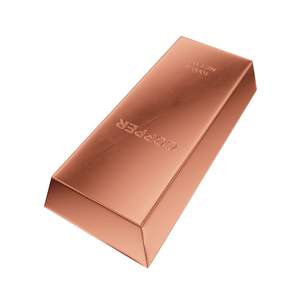
(ASTM B152 EN 14306Plumbing Electrical wiring Heat exchanger Copper round bar Copper Rod)
Company Profile
Copper Channel is a trusted global metal material supplier & manufacturer with over 12-year-experience in providing super high-quality copper products and relatives products.
The company has a professional technical department and Quality Supervision Department, a well-equipped laboratory, and equipped with advanced testing equipment and after-sales customer service center.
If you are looking for high-quality copper materials and relative products, please feel free to contact us or click on the needed products to send an inquiry.
Payment Methods
L/C, T/T, Western Union, Paypal, Credit Card etc.
Shipment
It could be shipped by sea, by air, or by reveal ASAP as soon as repayment receipt.
FAQs of ASTM B152 EN 14306Plumbing Electrical wiring Heat exchanger Copper round bar Copper Rod
Q: What is the standard size for ASTM B152 EN 14306Plumbing Electrical wiring Heat exchanger Copper round bar Copper Rod?
A: Copper bars are available in a variety of sizes, with common dimensions ranging from small squares or rectangles of a few millimeters in thickness to large sections several inches thick and wide. Exact sizes can be customized to order.
Q: Can ASTM B152 EN 14306Plumbing Electrical wiring Heat exchanger Copper round bar Copper Rod be welded?
A: Yes, ASTM B152 EN 14306Plumbing Electrical wiring Heat exchanger Copper round bar Copper Rod can be welded using various techniques, including gas tungsten arc welding (GTAW), gas metal arc welding (GMAW), and shielded metal arc welding (SMAW), although proper preparation and technique are necessary to avoid issues like porosity.
Q: Is ASTM B152 EN 14306Plumbing Electrical wiring Heat exchanger Copper round bar Copper Rodsuitable for marine environments?
A: Yes, copper’s inherent corrosion resistance makes it suitable for use in marine applications, although specific alloys may be preferred for added protection against saltwater corrosion.
Q: How does the cost of ASTM B152 EN 14306Plumbing Electrical wiring Heat exchanger Copper round bar Copper Rod compare to other metals?
A: Copper tends to be more expensive than some common structural metals like steel due to its higher conductivity and relative scarcity, but its unique properties often justify the cost in specialized applications.
Q: Is ASTM B152 EN 14306Plumbing Electrical wiring Heat exchanger Copper round bar Copper Rod recyclable?
A: Absolutely, copper is one of the most recycled metals globally. Copper bars can be melted down and reused repeatedly without losing their inherent properties, contributing to a circular economy and sustainable practices.

(ASTM B152 EN 14306Plumbing Electrical wiring Heat exchanger Copper round bar Copper Rod)
